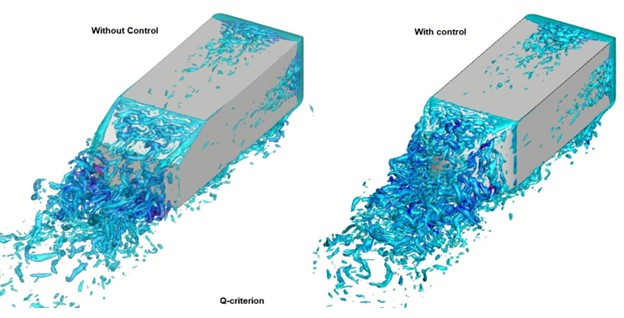Bluff Body Aerodynamics
This research’s long-term objective is to develop cost-effective drag-reduction devices and strategies specifically tailored for next-generation vehicles, such as electric and autonomous vehicles. Achieving this requires a deeper understanding of the aerodynamics of ground vehicles, characterized by complex, turbulent, three-dimensional flows. To this end, the research group focuses on gathering high-quality experimental data on the aerodynamics of complex bluff bodies and simplified road vehicle models. This experimental research is supported by computational fluid dynamics (CFD) studies, employing Reynolds-averaged Navier-Stokes (RANS) models and Detached Eddy Simulations (DES) to capture intricate flow dynamics. The research includes but is not limited to the following:
- Advanced Drag-Reduction Devices
Develop novel drag-reduction technologies, such as passive flow control devices, and vortex generators tailored to the design requirements of electric and autonomous vehicles. The research focuses on maximizing efficiency without increasing energy consumption, which is critical for extending the EV range.
- Impact of Shape and Surface Geometry on Aerodynamics
Explore how different body shapes, contours, and surface geometries impact flow separation, vortex formation, and pressure distribution on bluff bodies. This includes analyzing the aerodynamic implications of compact, flat, or curved designs likely to emerge in autonomous vehicle configurations. - Optimization of Rear Flow and Wake Structures
Study techniques to control wake dynamics and reduce drag in a vehicle’s rear section, where flow separation creates significant aerodynamic resistance. Research might include active flow control using small jets or flaps and passive methods to streamline airflow around rear surfaces. - Application of Active Flow Control Methods
Investigate active flow control solutions, such as pulsed air jets or movable surfaces, to dynamically alter flow patterns around bluff bodies. This could include studying how active systems adjust to changing driving conditions, enhancing stability and drag reduction.
These research directions aim to advance bluff body aerodynamics, providing practical solutions to optimize vehicle efficiency, stability, and functionality in diverse environmental conditions.
